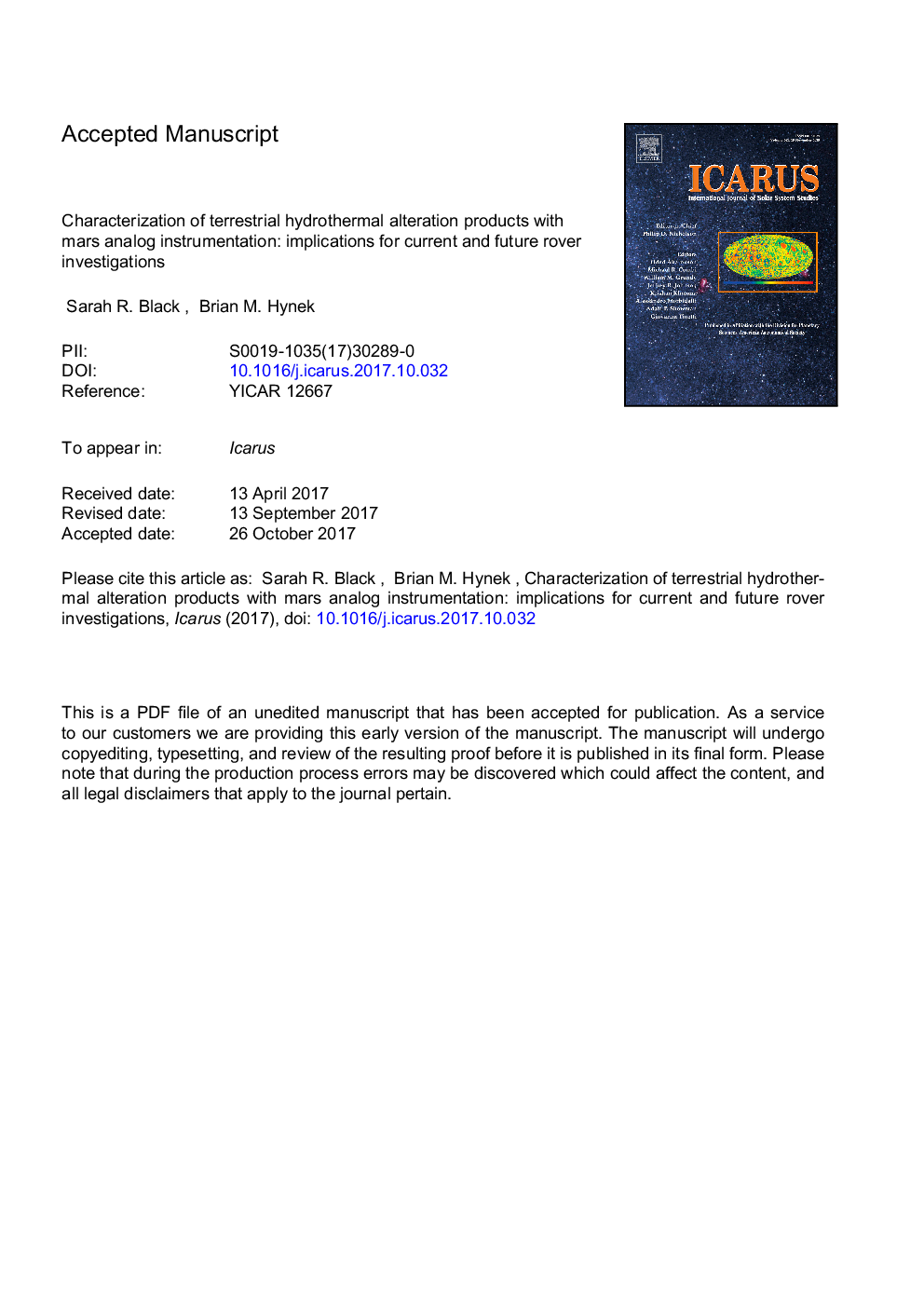| کد مقاله | کد نشریه | سال انتشار | مقاله انگلیسی | نسخه تمام متن |
|---|---|---|---|---|
| 8134239 | 1523484 | 2018 | 68 صفحه PDF | دانلود رایگان |
عنوان انگلیسی مقاله ISI
Characterization of terrestrial hydrothermal alteration products with Mars analog instrumentation: Implications for current and future rover investigations
ترجمه فارسی عنوان
تشریح محصولات دگرگونی های هیدروترمال زمینی با ابزار آنالوگ مریخ: پیامدهای تحقیقات فعلی و آینده
دانلود مقاله + سفارش ترجمه
دانلود مقاله ISI انگلیسی
رایگان برای ایرانیان
کلمات کلیدی
موضوعات مرتبط
مهندسی و علوم پایه
علوم زمین و سیارات
علوم فضا و نجوم
چکیده انگلیسی
Interpretation of Martian geology relies heavily on our understanding of terrestrial analog deposits and our ability to obtain comprehensive and accurate mineralogical compositions. Many previous studies of terrestrial hydrothermal deposits relied on limited datasets and/or did not use instruments analogous to those deployed on Mars. We analyzed 100 hydrothermally altered basalts from Costa Rica, Nicaragua, and Iceland with Mars analog Visible to Short Wave Infrared (VSWIR) spectroscopy, X-ray Diffraction (XRD), and Raman laser spectrometry. Alteration mineralogy consisted of amorphous and crystalline SiO2 (cristobalite, tridymite, quartz), Ca/Al/Fe/Mg-sulfates (gypsum, anhydrite, alunite, jarosite, hexahydrite, alunogen), Fe-, Ti-, and Mg-oxides/hydroxides (hematite, goethite, anatase/brookite, brucite), elemental sulfur, and phyllosilicates (montmorillonite, kaolinite). Results indicate VSWIR is best suited for identification of X-ray amorphous materials such as hydrated SiO2 and phyllosilicates, while XRD is best utilized for highly ordered crystalline materials such as sulfates, crystalline SiO2 polymorphs, elemental sulfur, and Mg-hydroxides identification. Surprisingly, XRD had the lowest identification rates for Fe-oxides/hydroxides (42% compared to 61% and 75% for VNIR and Raman, respectively), and nearly equal identification rates as VSWIR for kaolinite (76% for VSWIR, 71% for XRD). Identification of phyllosilicates in XRD, while possible, is not as effective as VSWIR without extensive sample preparation. Our observed identification rates may be attributed to the relative abundance of materials-Fe-oxides/hydroxides being present as surface coatings, the presence of large amounts of kaolinite in some samples, and an increased particle size for kaolinite relative to other clays. Elemental sulfur and Fe- and Ti-oxides/hydroxides were more readily identified with Raman. With NASA's current focus on habitability, hydrothermally altered areas-which we know to host a wide range of microbial life here on Earth-are of high interest and it is likely that future rovers will encounter similar mineral assemblages. Therefore, future rovers would benefit from using a combination of these methods and expanding the VSWIR sampling range to the full 300-2500â¯nm to conduct a comprehensive mineralogical investigation.
ناشر
Database: Elsevier - ScienceDirect (ساینس دایرکت)
Journal: Icarus - Volume 307, June 2018, Pages 235-259
Journal: Icarus - Volume 307, June 2018, Pages 235-259
نویسندگان
Sarah R. Black, Brian M. Hynek,
